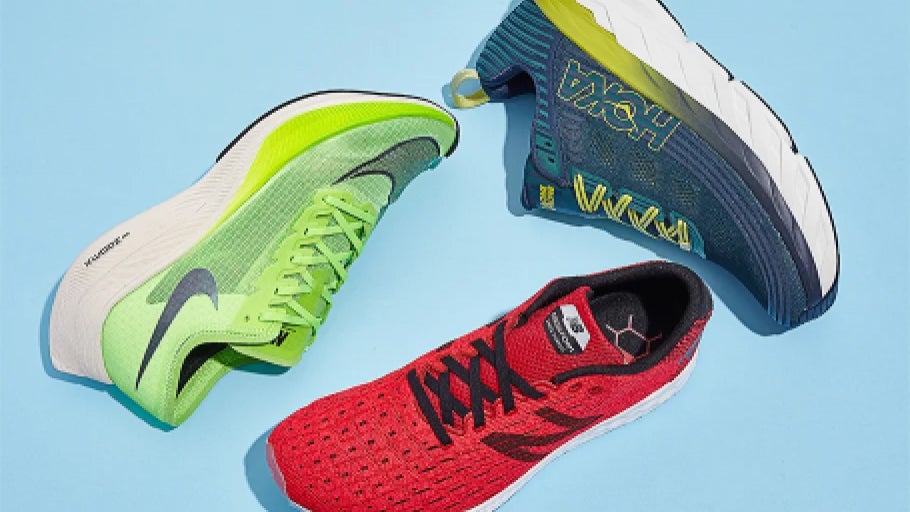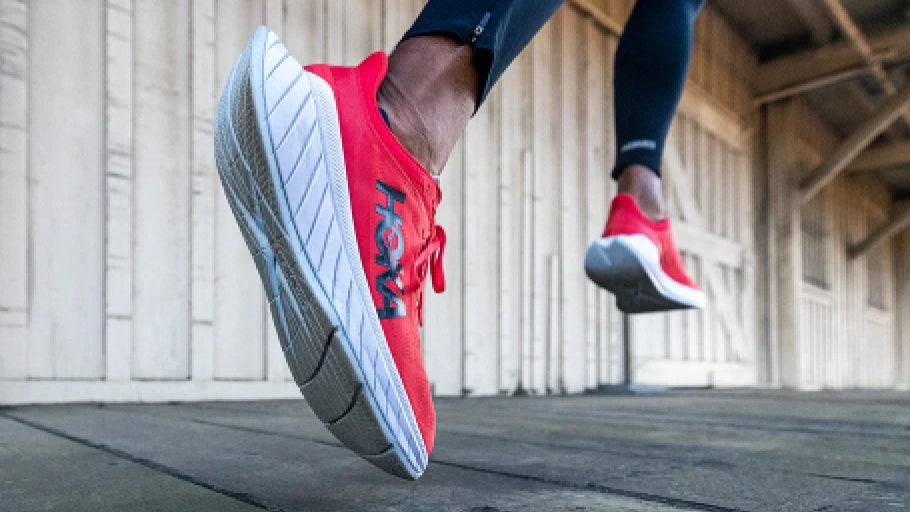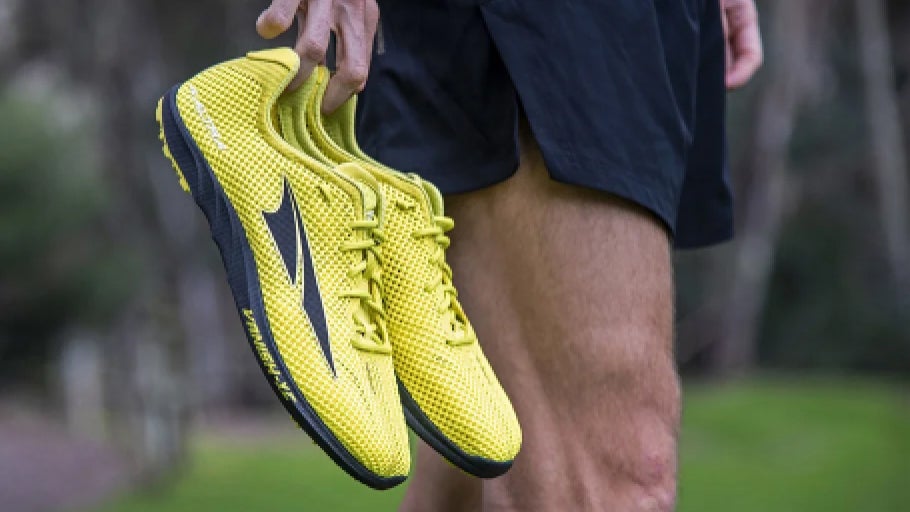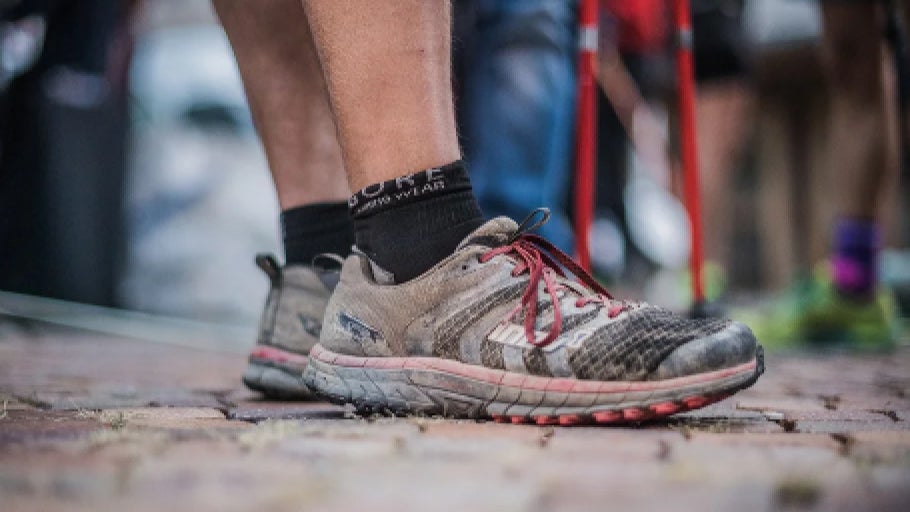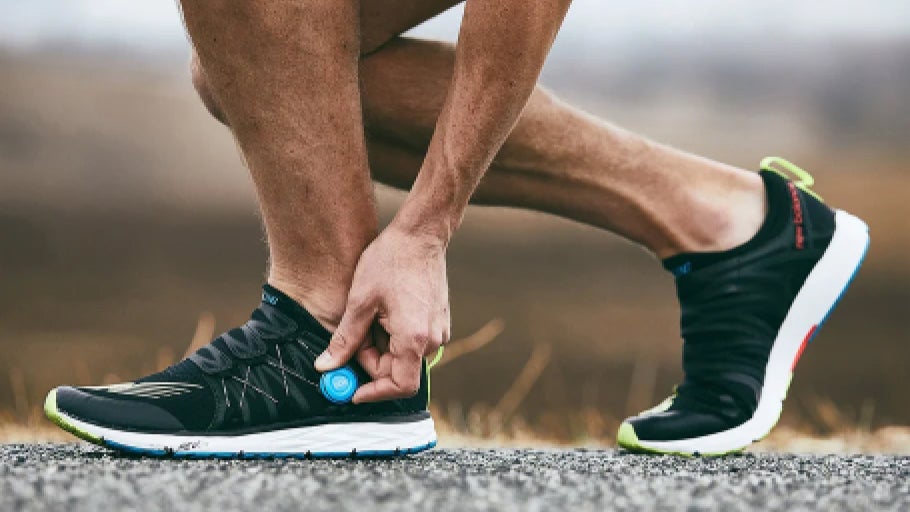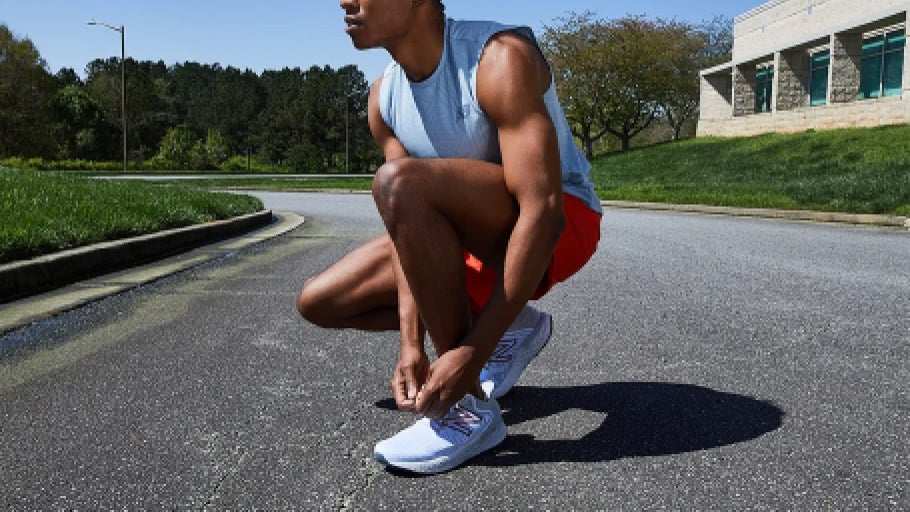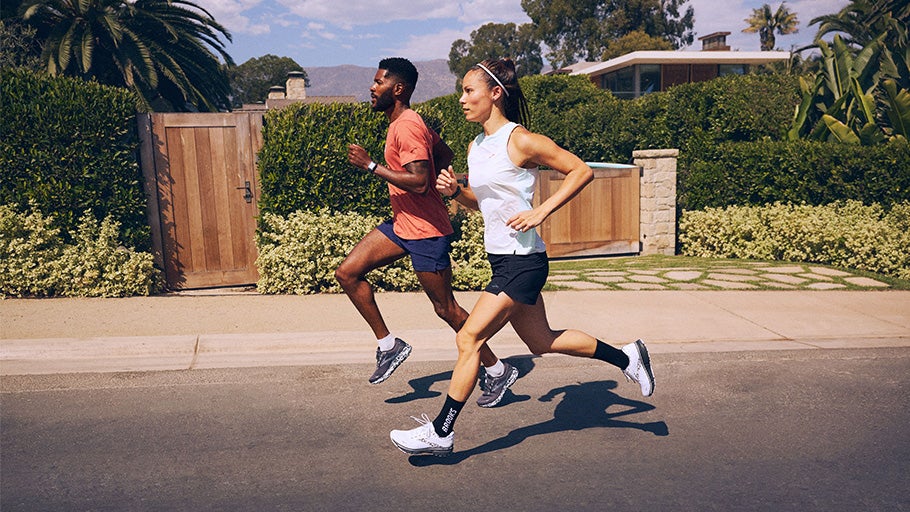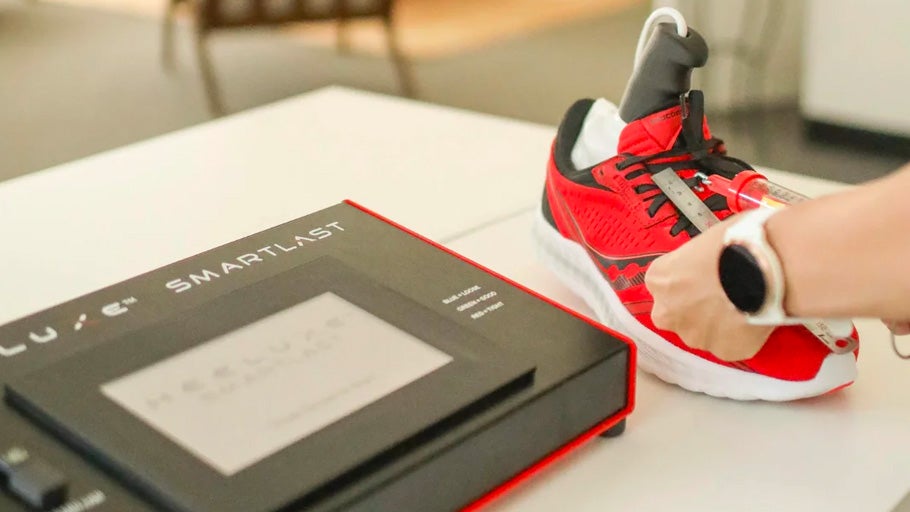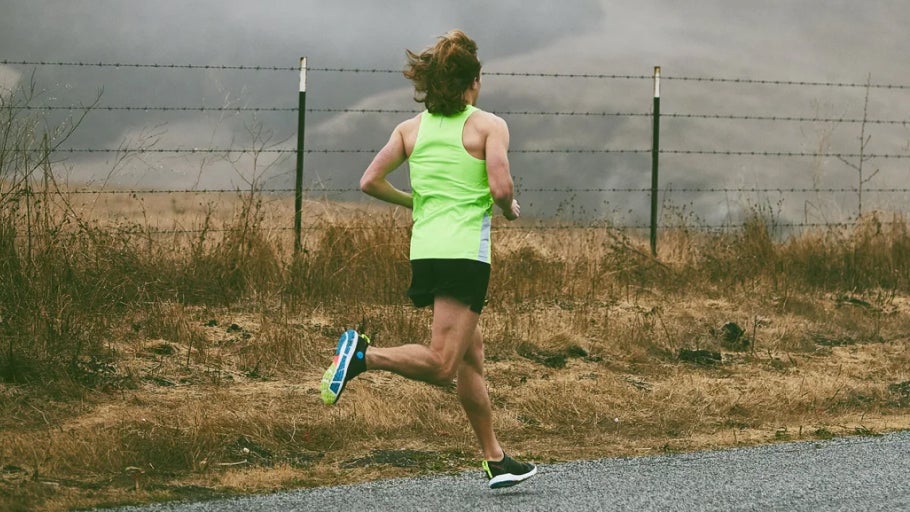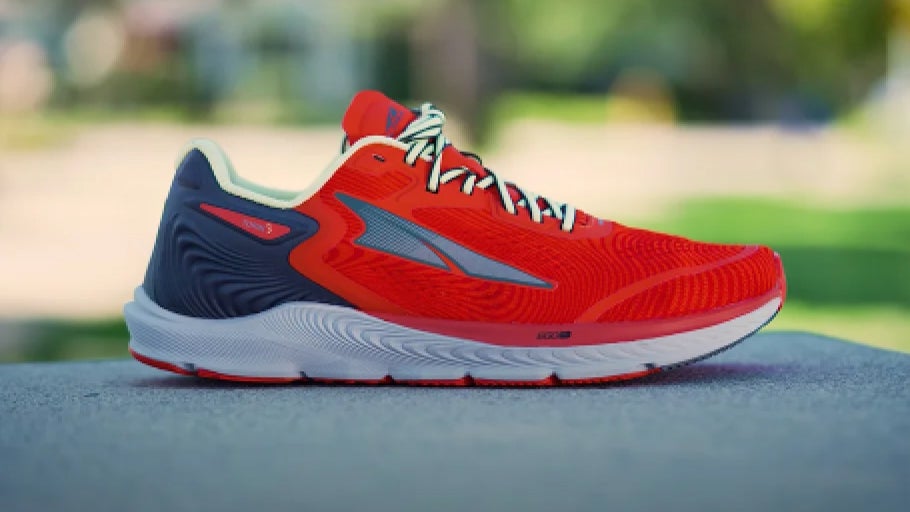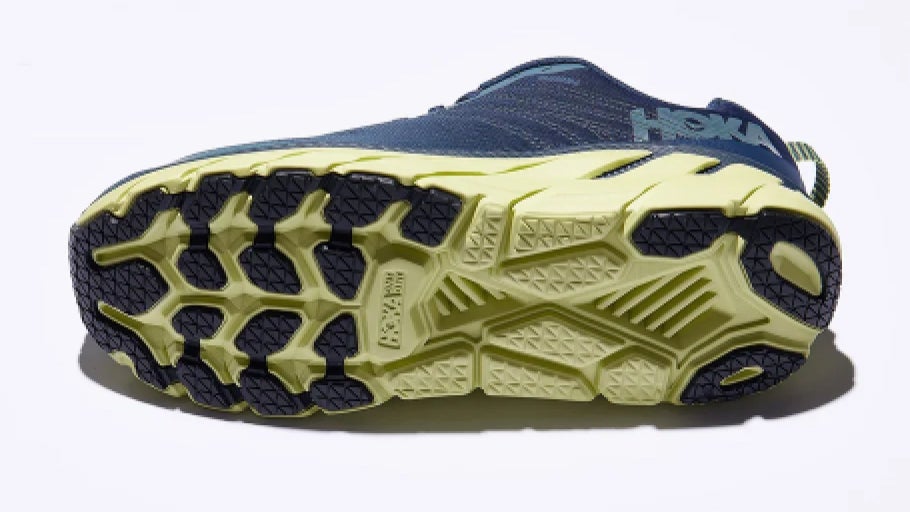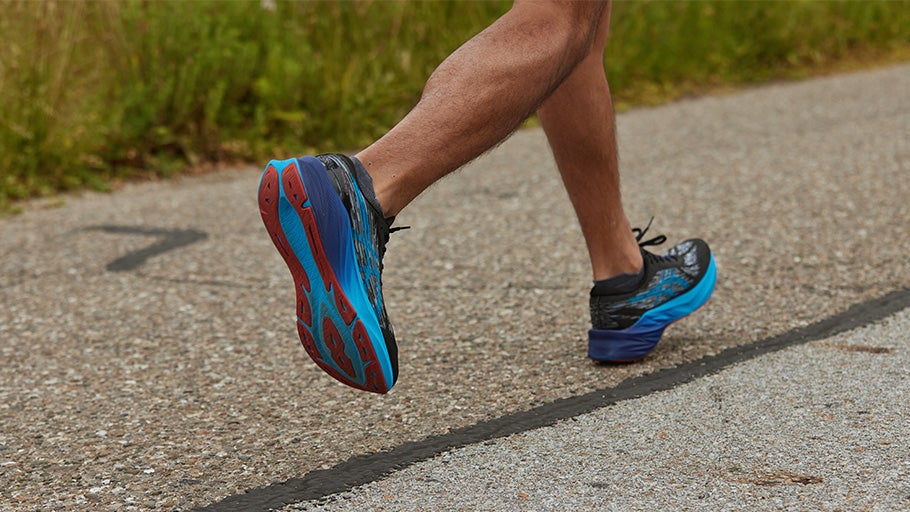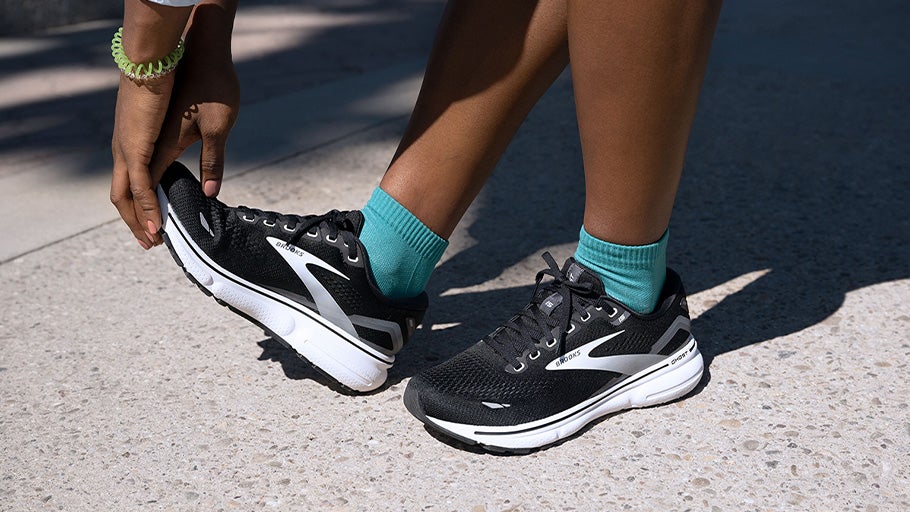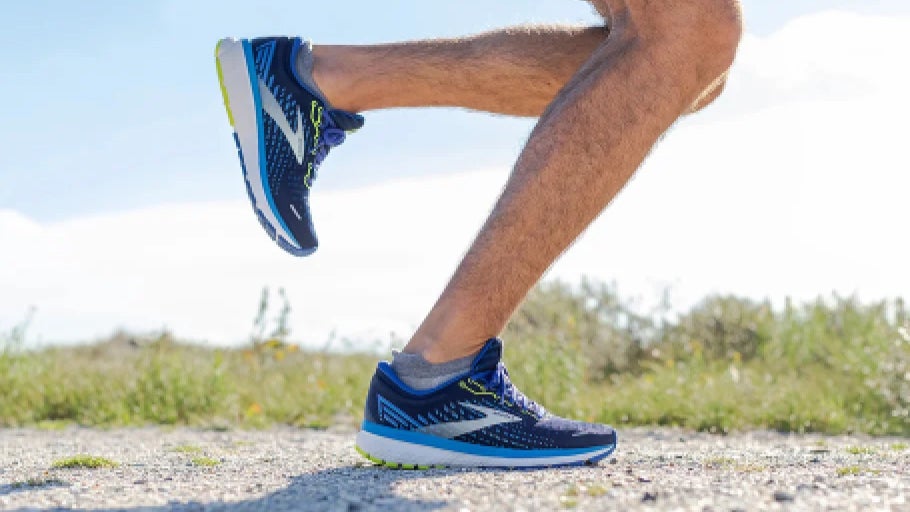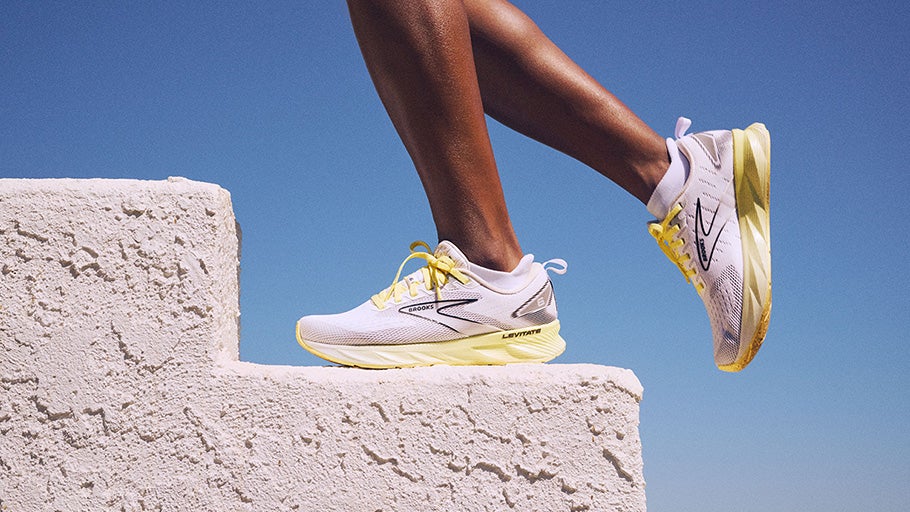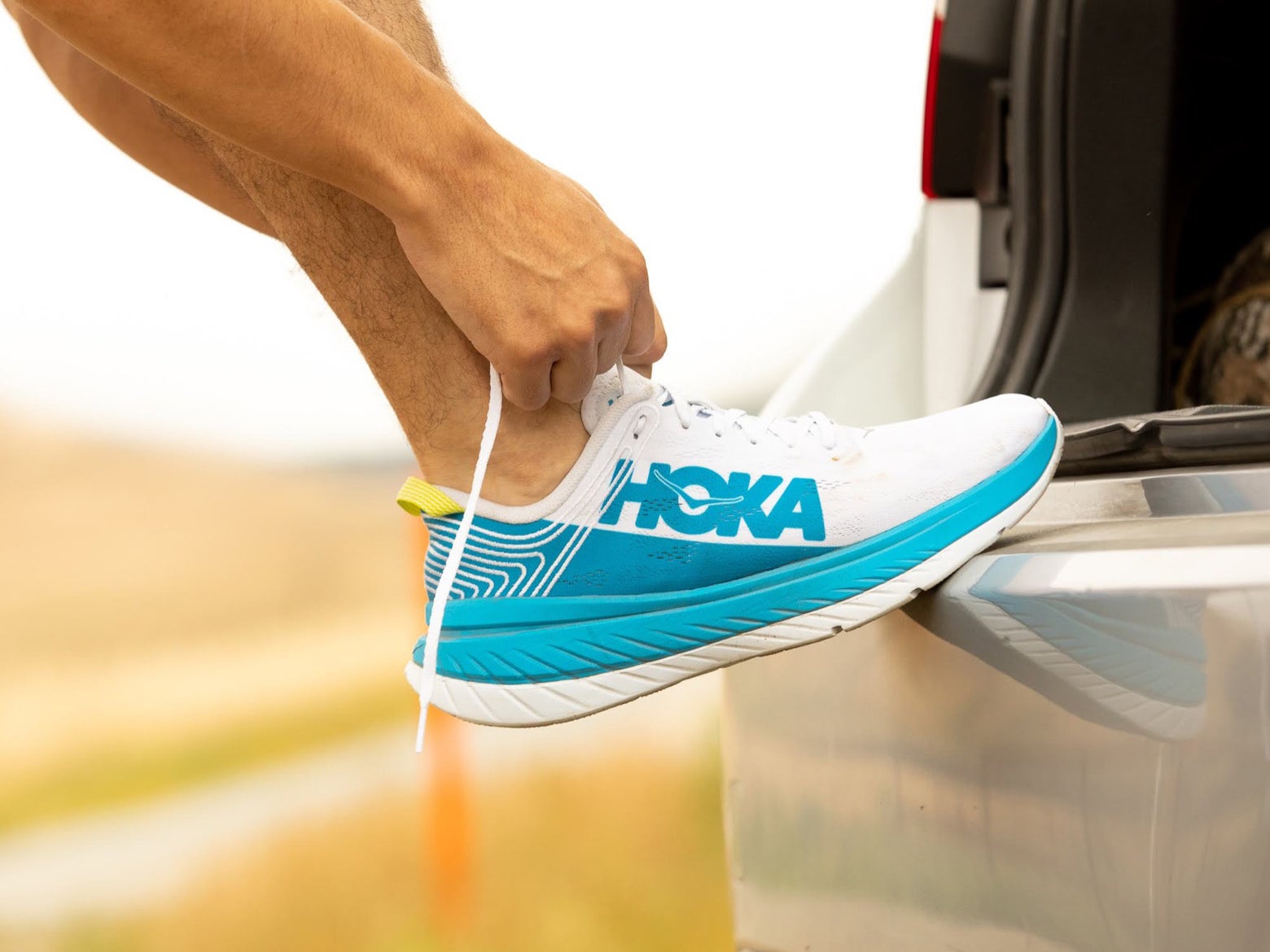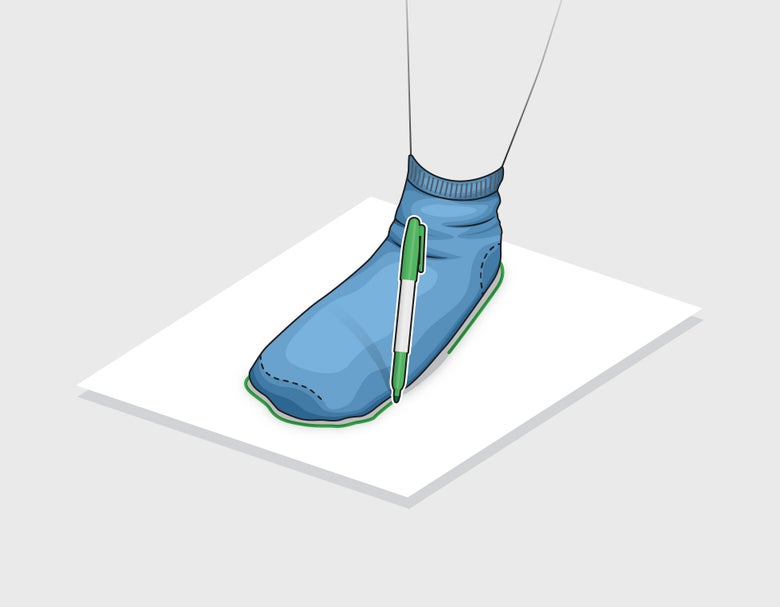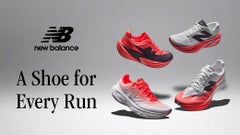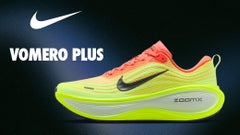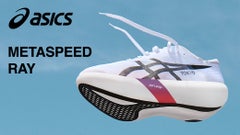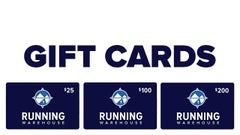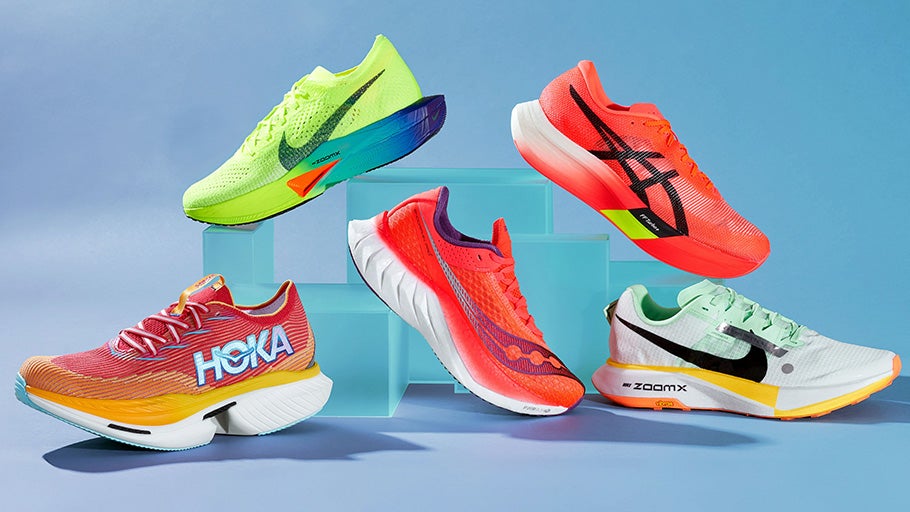
The Ultimate Guide to Find Your Running Shoe Size & Fit
Whether your feet are wide, narrow, or standard-width, or have high or low volume, finding the right shoe size is essential for comfort and injury prevention. Wearing the wrong size can lead to blisters, bunions, pain, and muscular imbalances that may derail your training.
Feet can change in length and width over time due to aging, pregnancy, or other factors, so it’s easy to wear the wrong size shoe without knowing it. Our three-step guide will help you find the perfect shoe fit, with tips to keep every run comfortable.
Step 1: How to Measure Your Foot
To get started, gather a sheet of paper or cardboard, a ruler or tape measure, and a pen. Place the paper on a hard, flat surface.
Put on the type of socks you plan to wear while running, then stand with one foot firmly on the paper. Keeping your weight evenly balanced, trace a thin line around your foot.
Measuring tip:
For accuracy, hold the pen straight up (perpendicular to the ground).
Step 2: How to Find Your Shoe Size
Find Your Size
Based on the measurements from Step 1, use the foot size conversion charts below to find your running shoe size. Match your length measurement with the recommended size.
Running Shoe Size Conversion Charts
Men’s Shoe Sizes
| Inches | CM | US Running | US Dress | UK | EU |
|---|---|---|---|---|---|
| 9 3/16 | 23.34 | 6.0 | - | 5.5 | 39.0 |
| 9 5/16 | 23.65 | 6.5 | 6.0 | 6.0 | 39.5 |
| 9 1/2 | 24.13 | 7.0 | 6.5 | 6.5 | 40.0 |
| 9 11/16 | 24.61 | 7.5 | 7.0 | 7.0 | 40.5 |
| 9 13/16 | 24.92 | 8.0 | 7.5 | 7.5 | 41.5 |
| 10 | 25.4 | 8.5 | 8.0 | 8.0 | 42.0 |
| 10 3/16 | 25.88 | 9.0 | 8.5 | 8.5 | 42.5 |
| 10 5/16 | 26.19 | 9.5 | 9.0 | 9.0 | 43.5 |
| 10 1/2 | 26.67 | 10.0 | 9.5 | 9.5 | 44.0 |
| 10 11/16 | 27.15 | 10.5 | 10.0 | 10.0 | 44.5 |
| 10 13/16 | 27.46 | 11.0 | 10.5 | 10.5 | 45.0 |
| 11 | 27.94 | 11.5 | 11.0 | 11.0 | 46.0 |
| 11 3/16 | 28.42 | 12.0 | 11.5 | 11.5 | 46.5 |
| 11 5/16 | 28.73 | 12.5 | 12.0 | 12.0 | 47.0 |
| 11 1/2 | 29.21 | 13.0 | 12.5 | 12.5 | 48.0 |
| 11 11/16 | 29.69 | 13.5 | 13.0 | 13.0 | 48.5 |
| 11 13/16 | 30.01 | 14.0 | 13.5 | 13.5 | 49.0 |
| 12 | 30.48 | 14.5 | 14.0 | 14.0 | - |
| 12 3/16 | 30.96 | 15.0 | 14.5 | 14.5 | 50.0 |
| 12 5/16 | 31.27 | 15.5 | 15.0 | 15.0 | - |
| 12 1/2 | 31.75 | 16.0 | 15.5 | 15.5 | - |
| 12 11/16 | 32.23 | 16.5 | 16.0 | 16.0 | - |
| 12 13/16 | 32.55 | 17.0 | 16.5 | 16.5 | - |
| 13 | 33.02 | 17.5 | 17.0 | 17.0 | - |
Women’s Shoe Sizes
| Inches | CM | US Running | US Dress | UK | EU |
|---|---|---|---|---|---|
| 8 1/2 | 21.59 | 5.0 | - | 2.5 | 35.5 |
| 8 11/16 | 22.07 | 5.5 | 5.0 | 3.0 | 36.0 |
| 8 13/16 | 22.38 | 6.0 | 5.5 | 3.5 | 37.0 |
| 9 | 22.86 | 6.5 | 6.0 | 4.0 | 37.5 |
| 9 3/16 | 23.34 | 7.0 | 6.5 | 4.5 | 38.0 |
| 9 5/16 | 23.65 | 7.5 | 7.0 | 5.0 | 39.0 |
| 9 1/2 | 24.13 | 8.0 | 7.5 | 5.5 | 39.5 |
| 9 11/16 | 24.61 | 8.5 | 8.0 | 6.0 | 40.0 |
| 9 13/16 | 24.92 | 9.0 | 8.5 | 6.5 | 40.5 |
| 10 | 25.4 | 9.5 | 9.0 | 7.0 | 41.5 |
| 10 3/16 | 25.88 | 10.0 | 9.5 | 7.5 | 42.0 |
| 10 5/16 | 26.19 | 10.5 | 10.0 | 8.0 | 42.5 |
| 10 1/2 | 26.67 | 11.0 | 10.5 | 8.5 | 43.5 |
| 10 11/16 | 27.15 | 11.5 | 11.0 | 9.0 | 44.0 |
| 10 13/16 | 27.46 | 12.0 | 11.5 | 9.5 | 44.5 |
| 11 | 27.94 | 12.5 | 12.0 | 10.0 | 45.5 |
| 11 3/16 | 28.42 | 13.0 | 12.5 | 10.5 | 46.5 |
| 11 5/16 | 28.73 | - | 13.0 | - | - |
Find Your Width
Most runners find a standard-width shoe comfortable, but if your feet are particularly wide or narrow, choosing a width that matches your foot shape can improve comfort and prevent injuries. Use the measurements from Step 1 along with your shoe size to select the right width for you.
Running Shoe Width Conversion Charts
Men’s Shoe Widths
| US Running | Narrow (B) in Inches | Medium (D) in Inches | Wide (2E) in Inches | Extra Wide (4E) in Inches |
|---|---|---|---|---|
| 6.0 | 3 3/16 | 3 9/16 | 3 15/16 | 4 5/16 |
| 6.5 | 3 1/4 | 3 5/8 | 4 | 4 3/8 |
| 7.0 | 3 5/16 | 3 11/16 | 4 1/16 | 4 7/16 |
| 7.5 | 3 3/8 | 3 3/4 | 4 1/8 | 4 1/2 |
| 8.0 | 3 7/16 | 3 13/16 | 4 3/16 | 4 9/16 |
| 8.5 | 3 1/2 | 3 7/8 | 4 1/4 | 4 5/8 |
| 9.0 | 3 9/16 | 3 15/16 | 4 5/16 | 4 11/16 |
| 9.5 | 3 5/8 | 4 | 4 3/8 | 4 3/4 |
| 10.0 | 3 11/16 | 4 1/16 | 4 7/16 | 4 13/16 |
| 10.5 | 3 3/4 | 4 1/8 | 4 1/2 | 4 7/8 |
| 11.0 | 3 13/16 | 4 3/16 | 4 9/16 | 4 15/16 |
| 11.5 | 3 7/8 | 4 1/4 | 4 5/8 | 5 |
| 12.0 | 3 15/16 | 4 5/16 | 4 11/16 | 5 1/16 |
| 12.5 | 4 | 4 3/8 | 4 3/4 | 5 1/8 |
| 13.0 | 4 1/16 | 4 7/16 | 4 13/16 | 5 3/16 |
| 13.5 | 4 1/8 | 4 1/2 | 4 7/8 | 5 1/4 |
| 14.0 | 4 3/16 | 4 9/16 | 4 15/16 | 5 5/16 |
| 14.5 | 4 1/4 | 4 5/8 | 5 | 5 3/8 |
| 15.0 | 4 5/16 | 4 11/16 | 5 1/16 | 5 7/16 |
| 15.5 | 4 3/8 | 4 3/4 | 5 1/8 | 5 1/2 |
| 16.0 | 4 7/16 | 4 13/16 | 5 3/16 | 5 9/16 |
| 16.5 | 4 1/2 | 4 7/8 | 5 1/4 | 5 5/8 |
| 17.0 | 4 9/16 | 4 15/16 | 5 5/16 | 5 11/16 |
| 17.5 | 4 5/8 | 5 | 5 3/8 | 5 3/4 |
Women’s Shoe Widths
| US Running | Narrow (2A) in Inches | Medium (B) in Inches | Wide (D) in Inches | Extra Wide (2E) in Inches |
|---|---|---|---|---|
| 5.0 | 2 3/4 | 3 1/8 | 3 1/2 | 3 7/8 |
| 5.5 | 2 13/16 | 3 3/16 | 3 9/16 | 3 15/16 |
| 6.0 | 2 7/8 | 3 1/4 | 3 5/8 | 4 |
| 6.5 | 2 15/16 | 3 5/16 | 3 11/16 | 4 1/16 |
| 7.0 | 3 | 3 3/8 | 3 3/4 | 4 1/8 |
| 7.5 | 3 1/16 | 3 7/16 | 3 13/16 | 4 3/16 |
| 8.0 | 3 1/8 | 3 1/2 | 3 7/8 | 4 1/4 |
| 8.5 | 3 3/16 | 3 9/16 | 3 15/16 | 4 5/16 |
| 9.0 | 3 1/4 | 3 5/8 | 4 | 4 3/8 |
| 9.5 | 3 5/16 | 3 11/16 | 4 1/16 | 4 7/16 |
| 10.0 | 3 3/8 | 3 3/4 | 4 1/8 | 4 1/2 |
| 10.5 | 3 7/16 | 3 13/16 | 4 3/16 | 4 9/16 |
| 11.0 | 3 1/2 | 3 7/8 | 4 1/4 | 4 5/8 |
| 11.5 | 3 9/16 | 3 15/16 | 4 5/16 | 4 11/16 |
| 12.0 | 3 5/8 | 4 | 4 3/8 | 4 3/4 |
| 12.5 | 3 11/16 | 4 1/16 | 4 7/16 | 4 13/16 |
| 13.0 | 3 3/4 | 4 1/8 | 4 1/2 | 4 7/8 |
Step 3: Make Sure Your Shoe Fits Right
Too big? Too small? Just right! Finding the Goldilocks standard for a perfect fit is attainable. Watch the video below on how to test out a shoe's fit right out of the box.
How to Check Your Shoe Fit
- A properly fitting running shoe should feel snug in the heel and midfoot, with wiggle room around the toes.
- While standing, press your thumb down next to the ball of your foot and around the toes. A good fit should allow for half to a full thumb's width of space.
- Hold the back of the shoe and try to raise your heel. There should be little to no movement.
- Check the eyelet rows on either side of the tongue. These rows should be close to parallel with each other.
Running Shoe Fit Tips
| Tip: | Explanation |
| Measure your feet each year | It’s a good idea to measure your feet every year. Your arches can change over time, sometimes lowering and lengthening your foot, or rising and shortening it. Shifts in weight and activity may also influence your shoe size. |
| Women's feet may become larger during and after pregnancy | Weight gain during pregnancy may cause permanent lowering of the foot arch resulting in a longer foot. |
| Your standard running shoe size is typically a half size larger than your casual shoe | In general, running in shoes that are a tad too large is preferable to running in shoes that are too small. |
| Fit your larger foot | Your left and right foot may differ by up to a full size. Always measure both feet and choose shoes based on your larger foot. A shoe that’s too small is more likely to cause problems than one that’s slightly too big. |
| Faster running calls for a snugger fit | A tighter shoe keeps you more connected to your feet at higher speeds, so sacrificing a bit of wiggle room can improve control. Many racing and performance shoes are designed with a snugger fit than everyday training shoes. |
| Sock thickness can affect shoe fit | Sock thickness can be used to modify shoe fit. Thinner socks increase space inside the shoe, while thicker socks provide a snugger fit. |
| Different lacing techniques can also affect fit | For more information, view the video below. |
How Lacing Techniques Can Affect Your Shoe Fit
Different shoe-lacing techniques can help resolve foot-related issues when running, such as heel slippage, blisters, hot spots, and bruised toes. Check out the video below to see the different shoe lacing techniques and how they can improve your fit!
Frequently Asked Questions
How do I know if I'm wearing the wrong shoe size?
If your toes feel cramped or your big toe or pinky toe is being pinched, the shoes are likely too small or short. On the other hand, if your heel slips despite tightening the laces, the shoes are probably too big. Remember the rule of thumb we discussed: your toes should have space to move, and your feet shouldn’t slide forward. Overall, aim for a snug, comfortable fit.
What is the difference between Men's and Women's shoe sizes?
There is approximately a 1.5 size difference between men's shoes and women's shoes. A woman would have to go down 1.5 size in men's shoes whereas a man would have to go up 1.5 shoe size in women's. For example, a women's size 7 is roughly equivalent to a men's 5.5.
How can I convert European shoe sizing to US sizing?
Please refer to our conversion chart for specific conversions for UK/Australia, Europe and US shoe sizes.
Finding the Perfect Running Shoe Fit
Finding the right running shoe size is key to comfort, injury prevention, and peak performance. Measure your feet regularly, account for changes in arch and foot width, and test your shoes with your usual socks and insoles. Use proper lacing, fit your larger foot, and choose shoes that provide snug support without restricting your toes. With the right fit, every run will feel more comfortable, controlled, and efficient.


